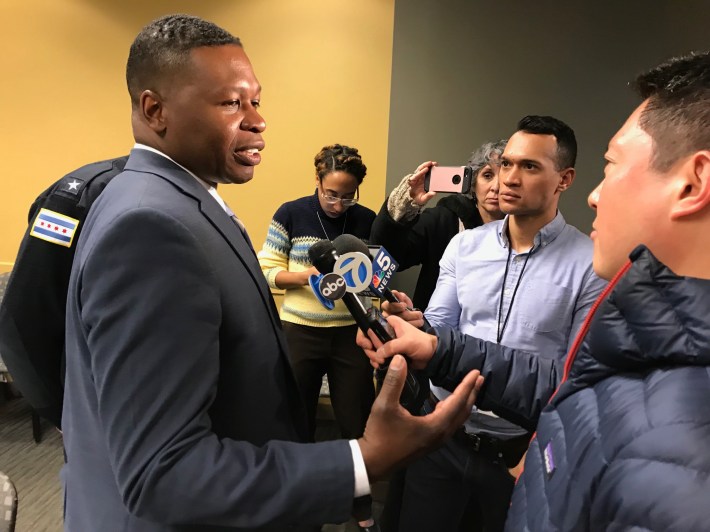In March 2017 the Chicago Tribune’s Mary Wisniewski uncovered massive discrepancies in the number of bike citations written in African-American communities versus majority-white ones. Despite city officials’ promises to get to the bottom of the problem, a February 2018 Tribune report showed that little had changed. For example, in 2017 police wrote 397 bike tickets in North Lawndale while – for the second year in a row – only five tickets were issued in Lincoln Park.
At the March 2018 MBAC meeting Oboi Reed, leader of the transportation justice group Equiticity, argued that the Chicago Police Department’s practice of concentrating bike tickets in Black neighborhoods is the city’s most pressing bike issue. He argued that zero-tolerance policies towards minor infractions like sidewalk biking and wrong-way riding were being used in communities of color as a pretense to stop and search residents for contraband like illegal drugs and guns.
After the meeting, CPD director of public engagement Glen Brooks Jr. he was asked if he believes the claim that bike ticketing was being used as an excuse for stop-and-frisk in African-American neighborhoods. “No, that’s not it,” he said. “I don’t think that’s it, anyway."
But at Yesterday's June MBAC meeting, Brooks essentially did a 180, acknowledging that police are using bike stops as a strategy to make arrests for serious crimes in communities of color.
Brooks told attendees the department recently conducted a study that looked at bike ticketing numbers for the police districts that saw most of the cycling citations. These figures were compared to the areas' racial demographics, the number of people ticketed for driving violations, and the level of violent crime.
The CPD looked at the where 3,300-plus tickets for sidewalk biking were issued and found that most of the tickets were written in five police districts, the 4th, 10th, 11th, 15th, and 25th. The 10th District includes most of North Lawndale and Little Village. The 15th District includes Austin south of Division Street. The 25th District includes the rest of Austin, all of Montclare, Hermosa, and Belmont-Cragin, and portions of Humboldt Park and Logan Square. The 4th District, the only South Side area on the list, includes East Side, Hegewisch, South Deering, South Chicago, Calumet Heights, Burnside, Avalon Park, and portions of South Shore. All of the districts are either majority black, majority Latino, or have significant Black and/or Latino populations.

(When asked why the study didn't include Uptown, which was cited as one of the hot spots in the Tribune article, Brooks said that CPD specifically looked at entire districts that had larger-than-average ticketing numbers. And while there was a beat in Uptown that was above average, overall the 17th District was within the norm.)
“In each of those areas, we had disproportionately high number of violent incidents,” Brooks said. “In communities that have a higher violence concentration, part of our violence reduction safety strategy is vehicle enforcement.” In these districts the study found that the police enforced both car and bike violations at similar rates.
Brooks said that the reason for higher rates of traffic enforcement in these districts is that, in areas with an above-average number of violent incidents, people who are violating traffic rules are more likely to be doing something else illegal, such as selling drugs or using illegal guns. Even using bikes for drive-by shootings “was not uncommon,” Brooks said. He said that about ten percent of traffic stops resulted in charges for more serious crimes such as drug or gun violations.
But Brooks emphasized that the police weren't trying to stop every single cyclist in these districts. “We're looking at behaviors that might be indicators for… violence,” he said. “We are not doing ticket missions for the sake of writing tickets.” He added that the fact that most of the cyclists being ticketed are Black or Latino reflects neighborhood demographics.
Brooks added that part of the CPD’s traffic enforcement strategy is educating residents cyclists and drivers about traffic laws. The study found that in practice it’s rare for officers to do this kind of outreach, and Brooks said he wanted to start working with cycling groups to address this issue as soon as possible.
While some attendees were receptive to the idea of police doing more traffic safety education, others expressed reservations about the report’s other conclusions. They argued that the study didn't fully address what they said was a citywide problem influenced by entrenched racial biases.
Jacob Peters, one of the council’s community representatives, said that he realized that it’s a challenge for officers to balancing the need to effectively fight crime with respecting residents’ civil rights. But he argued that the CPD still needs to do more to address racially-based bike ticketing discrepancies. “It doesn't matter that the intent it is to crack down on violence in the neighborhood if the result is still [residents] feeling like 'I'm getting harassed in my neighborhood.'”






